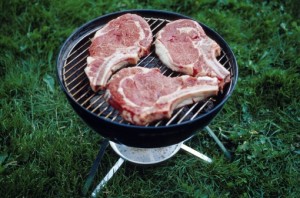I AM Exercising! Why Dont I Lose Weight?
I used to think my body was some kind of machine. I thought that losing weight was a simple matter of cutting the intake and/or increasing the output and soon I would look like your average Hollywood starlet. If I wanted to lose a pound, all I had to do was eat 3500 calories less than my maintenance level of 2000 calories a day or walk 35 miles or some combination of those.
If you were of the same opinion you have probably noticed, like me, that the reality isn't quite so simple. In fact, the August/September issue of ACE (American Council on Exercise) Certified News has an article by Ralph LaForge various factors that interact to determine just how many calories you burn during a given period of exercise.
If you just starve yourself, you get unhealthy and the body gets to be very efficient at maintaining your weight on very reduced levels of calories. You are always hungry so you get crabby. What weight you did lose was muscle and water, with some fat, so when you relent, as you must if you have any survival instincts, you gain back all the pounds plus some extra ones and they are NOT attractive, firm muscular pounds.
So you have a look at the magazines at the grocery checkout or your local newspaper and they convince you that you need to get moving, you need some horizontal movement, to get started down the road to slim, along with reasonable amounts of vegetables, fruits, protein sources, and whole grains. The idea is to create a 500 calorie per day deficit and then you'll lose a pound a week.
I ran out and bought a pedometer and vowed to let no day go by without at least 10,000 steps, which is around four miles for average walking strides, and cut out that 3:00 PM latte. That should be a 500 calorie a day deficit, I thought. A week later I stepped expectantly on the scales and perhaps saw a tiny bit of shift to the left. Oops, maybe I miscalculated. Have you tried this? Did it work for you?
Didn't think so. Actually that idea doesn't take into account the basal metabolism rate (BMR), which is the most important factor in determining our overall metabolic rates. The BMR determines the calories that you would be burning even if you were fast asleep, which need to be subtracted from your projected deficit total.
Our BMR is in turn affected by a number of factors, some of which are beyond our control. You can't really do much about your genetics, your gender, your age, your internal body temperature, or how much thyroxin or adrenalin your body is releasing at the moment. But it also depends on how much you weigh, your body surface area, your lean body mass, whether you're in starvation mode, and other things you can influence over time.
Taken together the number of factors that can influence you BMR and their interactions make it hard to estimate accurately. But when it comes to determining how much effect it has on calorie burn during exercise, the other major component is how much energy you're putting out during the exercise itself.
Your current weight affects how many calories you burn doing any given exercise, which makes perfectly good sense. The more mass you are moving, the more energy it takes to do it. But the point is to reduce that mass, right? Especially the fatty part of it.
The duration and intensity of the exercise is the major factor in determining its calorie and fat burning effects both during and after the exercise. For example, as Mr. La Forge points out, if a 154-pound person walks a mile at a rate of 3.5 miles per hour, she burns 54 calories. If she walks faster, say in the 3.5 to 5 m.p.h. range, it's 97 calories, and 107 calories if she jogs it. So it's not just the distance but how much effort you exert in covering that distance that counts.
Using a treadmill reduces your effort and so also reduces your calorie burn. Exercise that doesn't fight gravity, like swimming or cycling, use fewer calories to cover that distance, too.
So now we know it's good to do 10,000 steps every day but it is better to slowly work up to doing them faster. The basic aerobic exercise formula says you should determine your maximum heart rate (220 minus your age in years) and strive to maintain a level of exertion that keeps your pulse at 70 to 85 percent of that for 30 to 60 minutes in a row for at least 5 days of the week. That would be a good thing.
Seems there's an even better thing called interval training. That's where you start slowly, say about 50 percent of your maximum heart rate for 5 minutes, then put on a burst to about 90 percent of max for 60 seconds, slow down again for 75 seconds, then another minute at close to full throttle, slow down for 75 seconds, and so on for four or so more rounds. Then take five minutes at 30 percent to cool down. That's just one example of a schedule you could use.
So what do you accomplish with that? There was a study done at Laval University in Canada that compared results after standard aerobic conditioning (endurance) versus interval training. The standard aerobic group worked out longer, 45 minutes per session, 6 sessions per week for 20 weeks in a row (90 sessions), while the interval group did 30 minute sessions, 6 sessions per week for 15 weeks (60 sessions). The endurance group also burned twice as many calories during each session as the interval group.
One would expect that the endurance group would have lost more fat, assuming similar diets for the two groups. But it turns out that the interval group reduced their body fat NINE times more than the endurance group. The reason is that the interval training boosts the resting metabolic rate so they burned more calories even when they weren't exercising. Sound good?
Don't just get up off the couch and start sprinting. You have to work up to this and check with your doctor. But, as part of an overall training program, along with weight (resistance) training and flexibility/balance training, interval training is a good way to get the fat to burn off. Sometimes being a little breathless isn't a bad thing.
-
Fast Weight Loss Using Herbs And Spices
I wonder how much it is generally known that the benefits of using he
-
Taking the Extreme Makeover
The Extreme Makeover Program of the Body Makeover Systems is abou
-
Are You Buying Genuine Hoodia Gordonii
It is necessary to do a little research, before you can be sure that t
-
Turn Off That TV!
If youre serious about losing weight and
-
Glycogen Levels And The Secret Reason Why You Are Fat
Glycogen is the name for carbohydrates that are stored in your muscles
-
Nutritious Frozen Foods Can Play Role In Weight Loss Programs
Weight Loss Programs Size matters when it comes to meal portions in we
- DON'T MISS
- 5 Super Simple Weight Loss Tips
- Why You Should Do a Detox and 10 Things To Look For In Your Detox Program
- Enhance Weight Loss And Overcome Your Plateau With These 5 Easy Tips
- Tough Love Tips If You Have 10 Pounds To Lose
- Easy Weight Loss And Other Lies
- Endometriosis Awareness Month 2016, PCOS, pregnancy risks, pelvic pain in women, and weight loss
- 3 Ways To Lose The Muffin Top And Feel More Confident
- Overcoming The Factors Of Overeating
- 10 Metabolism Boosters Ranked By Effectiveness
- 17 Ways to Skinny Up Your Fridge




